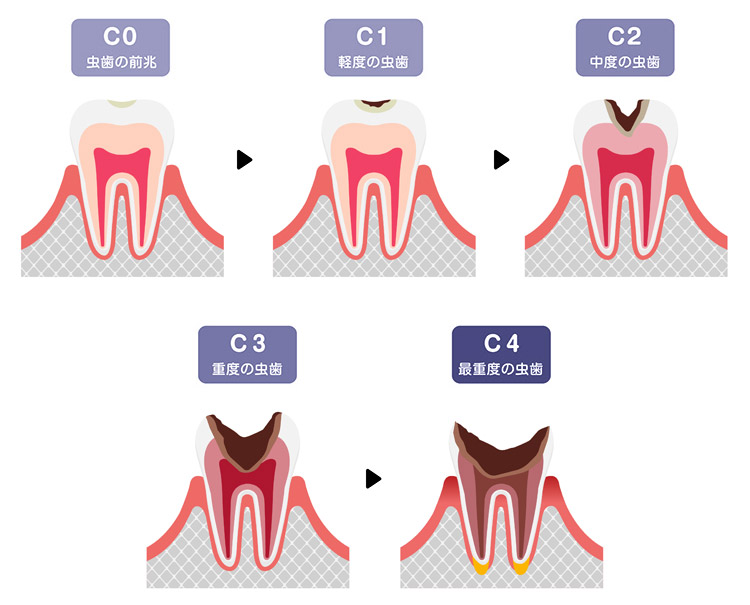
Early detection for minimal treatment
Once an adult tooth is lost, it will never grow back to its original state. Not only will it be dissolved by the acid produced by bacteria in the mouth, but tooth structure removed during cavity treatment will not regenerate either. For this reason, early detection and treatment of cavities is of utmost importance.
If cavities are discovered early, the amount of tooth structure that needs to be removed can be kept to a minimum. In particular, our clinic focuses on conservative treatment, which involves removing as little tooth structure as possible. We aim to preserve as much of the patient's own teeth as possible and minimize damage to the teeth.
Step-by-step dental treatment


*Tap to enlarge image
Treatment for tooth decay varies depending on the stage of progression.
Treatment for CO (precursor to tooth decay)
CO is an early stage of tooth decay, and there are no holes on the surface of the tooth. The only characteristic is the appearance of "white spots" described as white spots or opacity. There is no need to grind the teeth, and fluoride is applied to promote remineralization. It is also necessary to instruct patients on brushing and improving hygiene.
Treatment for C1 (mild caries)
C1 is a cavity in the enamel. There is a relatively shallow hole on the tooth surface. At this stage, there is no pain, but in some cases, cold food may hurt. The treatment is completed by scraping off the tooth structure affected by bacteria and filling it with composite resin.
Treatment for C2 (moderate caries)
C2 is a dentin cavity. The hole on the tooth surface tends to be relatively deep and large. Cold or sweet foods induce toothache. After removing the affected area, the treatment is completed by making and fitting a filling or cap.
Treatment for C3 (severe caries)
C3 is a cavity that has reached the tooth pulp. Because the nerve of the tooth is affected, it becomes very painful. Pain can be induced not only by cold or sweet things, but also by hot things. A tingling pain may occur even when you are at rest.
The treatment is completed by removing the tooth nerve, performing root canal treatment, and making and fitting a cap.
Treatment for C4 (most severe caries)
C4 is the final stage of tooth decay. The crown, which is the top part of the tooth, has collapsed, leaving only the root. Because the nerve in the tooth has died, no pain is felt. In most cases, when the disease has progressed to this stage, extraction is the appropriate course of action. After extraction, the missing part is filled with a prosthetic device such as a bridge, denture, or implant.
There are other treatments like this
List of recommended treatments
Comprehensive oral examination(Dental check-up)
For those who want early detection and treatment of cavities and more reliable prevention
Click here for more information on comprehensive oral examinationscleaning
For those who are worried about early stages of tooth decay or suspect they may have tooth decay
Click here for more information on cleaningRoot canal treatment
For those who are worried about severe or recurrent cavities
Learn more about root canal treatment here

